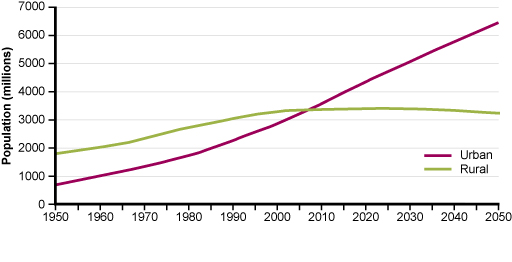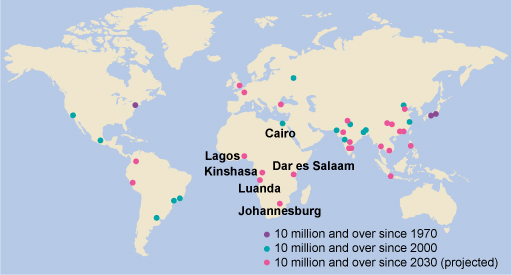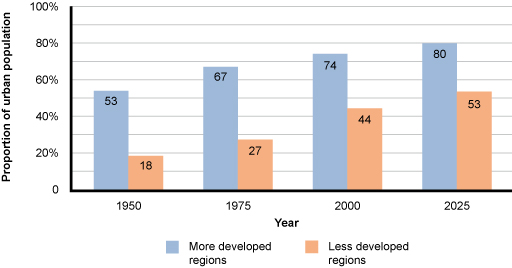5.1.1 Global trends in urbanisation
In 1960, the global urban population was 34% of the total; however, by 2014 the urban population accounted for 54% of the total and continues to grow. By 2050 the proportion living in urban areas is expected to reach 66% (UNDESA, 2014). Figure 5.1 shows the change in the rural and urban populations of the world from 1950 through to projected figures up to the year 2050.

From Figure 5.1, in which year did the number of people living in urban areas first exceed the number living in rural areas?
The two lines cross at about 2007 or 2008. This is when urban first exceeded rural population.
The process of urbanisation affects all sizes of settlements, so villages gradually grow to become small towns, smaller towns become larger towns, and large towns become cities. This trend has led to the growth of mega-cities. A mega-city is an urban area of greater than ten million people. Rapid expansion of city borders, driven by increases in population and infrastructure development, leads to the expansion of city borders that spread out and swallow up neighbouring urban areas to form mega-cities. In 1970, there were only three mega-cities across the globe, but by the year 2000, the number had risen to 17 and by 2030, 24 more mega-cities will be added (see Figure 5.2).

From Figure 5.2, in Africa how many mega-cities are predicted to exist by 2030 and how many have already existed since the year 2000?
Six mega-cities are predicted to exist in Africa by the year 2030 – Luanda (Angola), Lagos (Nigeria), Johannesburg (South Africa), Kinshasa (Democratic Republic of Congo), Dar es Salaam (Tanzania) and Cairo (Egypt). There is one mega-city, Cairo, which has had a population of more than 10 million since 2000.
The global trend in urbanisation is not the same in all parts of the world. Asia and Africa currently have the highest rates of urbanisation. Figure 5.3 shows a comparison of trends in more or less developed regions of the world.

In Figure 5.3, how would you describe the trends in urban growth in more and less developed regions during this century?
The growth of urban populations in less developed regions is increasing at a faster rate than developed regions. In 2000, in more developed parts of the world 76% of the population lived in urban areas and a small increase to 83% is forecast by 2030. In less developed regions, there was a much smaller proportion living in urban areas in 2000 (only 40%) but this is expected to increase significantly to 56% by 2030.
5.1 Urbanisation trends
